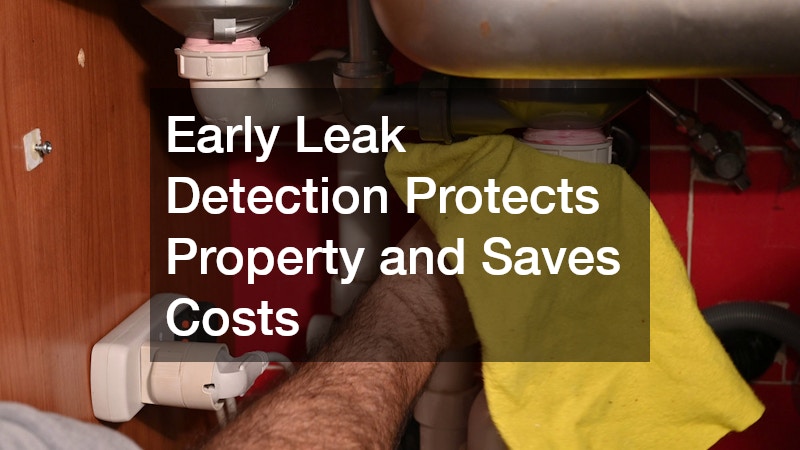Why Early Leak Detections Are Crucial for Property Maintenance
Understanding the importance of early leak detection can significantly improve property maintenance strategies. Timely identification and repair can prevent extensive damage, save money, and increase the longevity of the property. This article dives deep into the necessity of early leak detection and lays out various strategies to integrate efficient detection techniques into property management plans.
How Does Leak Detection Work?
Modern Techniques in Leak Detection
Modern leak detection leverages cutting-edge technology to identify and address leaks swiftly. Techniques such as acoustic sensors, infrared thermography, and smart water meters enable precise and non-invasive diagnostics.
Infrared technology, for instance, can detect temperature discrepancies indicative of water leaks behind walls or under floors. By continuously monitoring for anomalies, these advanced tools provide real-time diagnostics that empower property managers to act promptly.
The integration of IoT (Internet of Things) devices allows for continuous monitoring and immediate alerts when discrepancies are detected. This proactive approach minimizes potential damage, safeguarding both the property’s structure and value. As advanced methods become more affordable, a broader range of properties can benefit, maximizing efficiency in maintenance tasks while reducing operational costs.
Traditional vs. Advanced Leak Detection Methods
Traditional leak detection often relied on subjective assessments and manual inspections, leading to delayed or missed detections. Advanced technologies, on the other hand, offer objective data-driven results, enhancing accuracy. The shift to technology-centric methods significantly reduces investigation time and labor costs associated with identifying concealed leaks. Such advancements are transforming a reactive maintenance strategy into a proactive one, where issues are corrected before they escalate.
Comparatively, techniques like visual inspections and manual auditory checks offer rudimentary efficiency but can lead to guestimations and oversights. Modern systems go beyond surface-level checks, providing unparalleled precision and early detection capabilities. This evolution from traditional to advanced methods represents a substantial improvement in maintaining the integrity and stability of a property’s infrastructure.
What are the Risks of Ignoring Early Leak Signs?
Structural Damage and Health Hazards
Ignoring early leak signs can lead to significant structural damage, as water infiltration weakens foundations and destabilizes critical building components. Over time, persistent exposure to moisture promotes wood rot, mold development, and erosion of structural integrity. Mold, resulting from unchecked leaks, can pose serious health risks to inhabitants, aggravating allergies and respiratory conditions. Long-term exposure can decrease air quality and substantially devalue the property.
One key issue is that leaks often remain hidden until they cause visible damage, making timely identification crucial. Health risks associated with water leaks extend beyond mold, contributing to pest infestations and the spread of bacteria. Recognizing these threats underscores the necessity for regular, proactive leak inspections to ensure safety and health standards are maintained.
Financial Implications of Late Detection
The financial impact of late leak detection can be severe, as repair costs skyrocket once issues are left unaddressed. This includes not only the direct costs of repair but also potential legal liabilities if occupant safety is compromised. Water leaks can lead to significant increases in utility bills as overlooked situations worsen, wasting resources such as water. Unchecked leaks often necessitate major renovations, further straining financial resources.
Delayed detection may also result in increased insurance premiums or denial of claims, compounding financial strain. Furthermore, late detection undermines the long-term value of the property, affecting potential resale opportunities. These financial repercussions highlight the importance of incorporating early detection strategies into property maintenance protocols.
How Can Early Leak Detection Save Money?
Cost-Efficiency in Preventative Maintenance
Incorporating early leak detections into property maintenance is a cost-efficient preventative measure that saves substantial amounts over time. Addressing minor leaks swiftly prevents small issues from escalating into costly repairs. By detecting and resolving leaks early, property owners can avoid significant structural repairs and elongated downtime. Early intervention ensures minimal disruption, maintaining tenant satisfaction and occupancy rates.
Adopting a preventative maintenance strategy minimizes energy waste and optimizes utility consumption. When problems are identified before they worsen, properties remain in peak operational condition, reducing the risk of unexpected expenses. This proactive approach not only preserves funds but also promotes a longer-lasting infrastructure.
Case Studies in Early Leak Detection Success
Several real-world examples demonstrate the economic benefits of early leak detection, offering valuable insights for property managers. In one instance, a commercial building employed advanced sensors to monitor pipes and reduce water consumption by 30% within a year. The technology prevented a potential $100,000 loss due to undetected leaks, underscoring its effectiveness in risk management. Another case involved a multi-family property where smart leak detectors alerted maintenance personnel to a minor pipe leak before it caused any structural damage.
This preemptive action saved the property management company an estimated $80,000 in potential repair and renovation costs. These success stories emphasize the value of an integrated leak detection system in maintaining both the economic and physical health of properties. By investing in early detection technologies, property managers ensured long-term sustainability and tenant safety, showcasing how a small upfront investment can yield significant future savings.
Incorporating early leak detection into property maintenance strategies not only protects the property’s structural integrity but also ensures economic efficiency. By staying vigilant and adopting modern leak detection techniques, property owners can mitigate risks, avoid costly repairs, and maintain a safe and secure environment. The continual evolution of leak detection technology offers even greater benefits, making these methods increasingly indispensable in property management.



